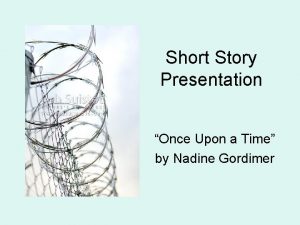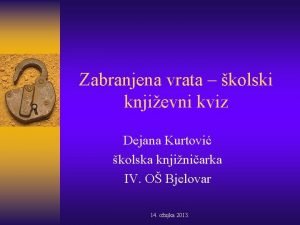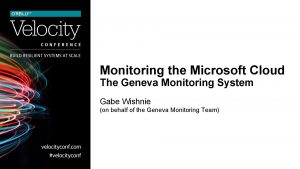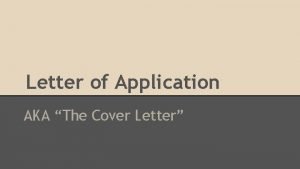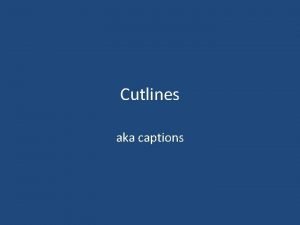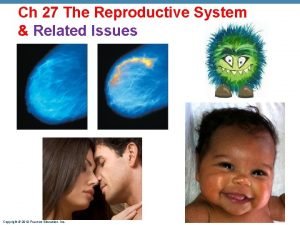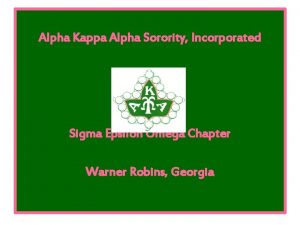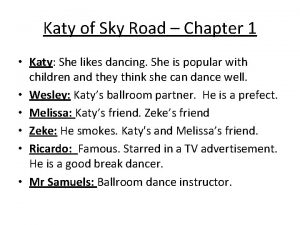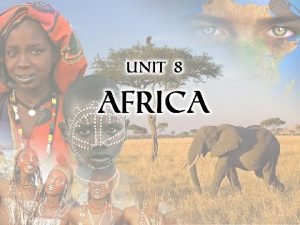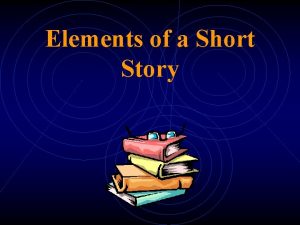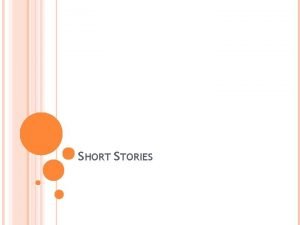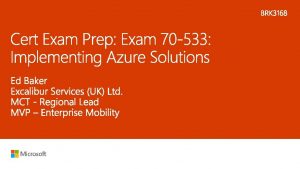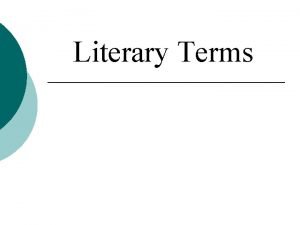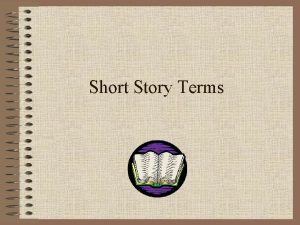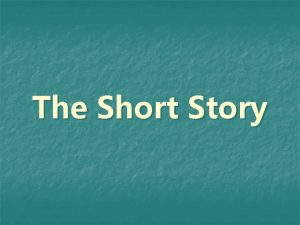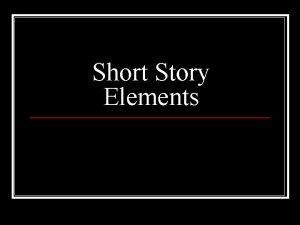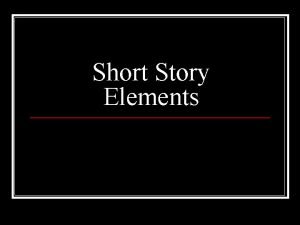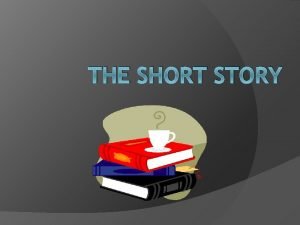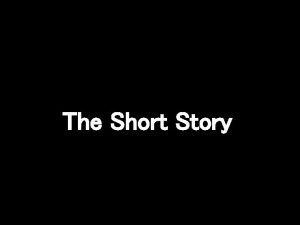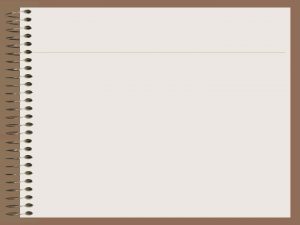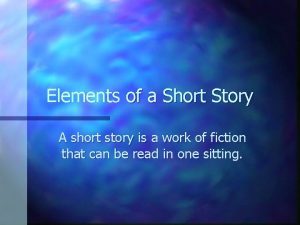SoWhat is a Short Story Its short aka

























- Slides: 25

So…What is a Short Story? • • • It’s short (aka economical)! Written in prose Fictional (fake, not factual) Typically in narrative form There is a conflict • Prose: writing that resembles everyday speech; free form (Ex: That novel was written in excellent prose. ) • Narrative: Sequence of events that follows a format; cause and effect

6 Elements of All Fiction • There is a: • Plot • Conflict • Setting • Character(s) • Mood • Theme/Moral/Purpose

Plot & Plot Structure • Plot: the literary element that the describes the structure of a story. It shows the arrangements of events and actions within a story. The most basic type of plot structure is pyramidshaped. Pg 4

Plot Components Climax: the turning point, the most intense moment—either mentally or in action Pg 4 Rising Action: the series of conflicts and crisis in the story that lead to the climax Falling Action: all of the action which follows the climax Exposition: the start of the story, the situation before the action starts Resolution: the conclusion, the tying together of all of the threads

Plot Structure of Romeo and Juliet Climax or Turning Point: Tybalt kills Mercutio, then Romeo kills Tybalt. The Prince arrives and orders that Romeo be banished from Verona. Rising Action: Balcony Scene…Romeo needs to secretly marry Juliet fearing that a Capulet and a Montague would never be permitted to do so openly. Inciting Incident: Romeo meets Juliet at the Capulet house and completely forgets about Rosaline. Exposition: Romeo shows his lust for Rosaline; normal conversations in Montague and Capulet families; Mercutio makes fun of Romeo because of Rosaline’s intent to never marry. Falling Action: Paris will soon be married to Juliet, and the Capulets do not know about Juliet’s secret marriage. Juliet decides to fake her death with a potion the Friar gives her. Moment of Final Suspense: Romeo is informed that Juliet is dead when she is really asleep from the potion. Romeo arrives at the Capulet burial vault ready to drink the poison the Apothecary sold him. Resolution: Death (since it’s a tragedy) Romeo drinks the poison and dies. Juliet wakes up, finds Romeo dead, and kills herself with a dagger when the Friar is not looking. Both families agree to stop the hatred after the tragedy.

6 Elements of All Fiction • There is a: • Plot • Conflict • Setting • Character(s) • Mood • Theme/Moral/Purpose

Conflict is the dramatic struggle between two forces in a story. Without conflict, there is no plot.

Types of Conflict External Internal

External Conflicts Internal vs. External Conflict Internal: Should I disobey the law in order to help the world?

6 Elements of All Fiction • There is a: • Plot • Conflict • Setting • Character(s) • Mood • Theme/Moral/Purpose

Setting - The time and place in which the story takes place - The definition of setting can also include social statuses, weather, historical period, and details about immediate surroundings. - Settings can be real or fictional, or a combination of both real and fictional elements.

6 Elements of All Fiction • There is a: • Plot • Conflict • Setting • Character(s) • Mood • Theme/Moral/Purpose

Character: Protagonist/Antagonist Protagonist: the main character of a work of literature, theater, or cinema. There may be more than one protagonist in a large piece of work or a work with several overlapping narratives. Antagonist: a character, group of characters, or other force that presents an obstacle or is in direct conflict with the protagonist. The antagonist is most often one character who has a goal that opposes the protagonist’s goal and will try to stop the protagonist from getting what he or she wants.

Character: Dynamic vs. Static Dynamic-a character that undergoes a significant, fundamental change in the way he views himself or the world Static-a character that remains the same and does not undergo any significant change

Character: Round vs. Flat • Round-a character that is defined by multiple traits and is fully-developed (Ex: Brutus) • Flat-a character that tends to be defined by a single trait and is not fully-developed (Ex: Casca)

Character: Direct vs. Indirect Characterization Indirect characterization: Learn about a character through 1. Character description 2. Things a character says/thinks 3. Things a character does 4. Things other characters think or say about t he character 5. Things other characters do around the character

Character: Foil

6 Elements of All Fiction • There is a: • Plot • Conflict • Setting • Character(s) • Mood • Theme/Moral/Purpose

Mood - Evokes certain feelings or vibes in readers through words and descriptions. - Mood is referred to as the atmosphere of a literary piece, as it creates an emotional situation that surrounds the readers. - Mood is developed in a literary piece through various methods. It can be developed through setting, theme, tone and diction. Author’s attitude Author’s word toward subject choice

6 Elements of All Fiction • There is a: • Plot • Conflict • Setting • Character(s) • Mood • Theme/Moral/Purpose

Theme - Underlying meaning of a literary work that may be stated directly or indirectly - The theme of a work is the central idea or insight. It represents the author’s ideas about the subject of the work. - The subject can usually be stated in a single word; theme requires a sentence.

Narration We must also consider narration in a short story Narrator: a person who gives an account or tells the story of events, experiences, etc.

First Person First person point of view involves the use of either of the two pronouns “I” and “we”

Third Person - Limited - a narrator reports the facts and interprets events from the perspective of a single character.

Third Person – Omniscient
 Tall + short h
Tall + short h Maikling kwento
Maikling kwento Once upon a time by nadine gordimer slideshare
Once upon a time by nadine gordimer slideshare Bright filled paperweight
Bright filled paperweight When a train increases its velocity its momentum
When a train increases its velocity its momentum Cloudy sunny rainy windy
Cloudy sunny rainy windy If its a square it's a sonnet summary
If its a square it's a sonnet summary Its halloween its halloween the moon is full and bright
Its halloween its halloween the moon is full and bright Its not easy but its worth it
Its not easy but its worth it Zabranjena vrata aka
Zabranjena vrata aka Shakespeare, aka the bard of
Shakespeare, aka the bard of Complete pay reward pyramid
Complete pay reward pyramid Akacatholic
Akacatholic Microsoft geneva monitoring
Microsoft geneva monitoring How to write a letter of interest for aka
How to write a letter of interest for aka I3on
I3on Httpts://aka.ms/remoteconnect
Httpts://aka.ms/remoteconnect Aka.msm
Aka.msm Http://aka
Http://aka Cutline vs caption
Cutline vs caption Aka sustentacular cells
Aka sustentacular cells Sigma epsilon omega aka
Sigma epsilon omega aka Phi pi omega chapter of aka
Phi pi omega chapter of aka åka skidor tjeckien
åka skidor tjeckien Tikkop meaning
Tikkop meaning Female pwo mask khan academy
Female pwo mask khan academy


